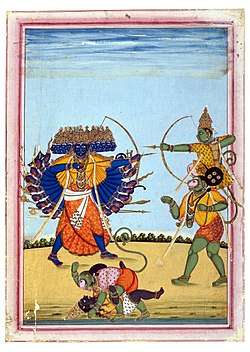Ramavataram
| Part of a series on |
| Hindu scriptures and texts |
|---|
 |
|
Rig vedic
Sama vedic Yajur vedic Atharva vedic |
|
Other scriptures |
| Related Hindu texts |
|
|
Timeline |
Ramavataram, popularly referred to as Kamba Ramayanam, is a Tamil epic that was written by the Tamil poet Kambar during the 12th century. Based on Valmiki's Ramayana (which is in Sanskrit), the story describes the life of King Rama of Ayodhya. However, Ramavatharam is different from the Sanskrit original in many aspects - both in spiritual concepts and in the specifics of the storyline.[1] This historic work is considered by both Tamil scholars and the general public as one of the greatest literary works in Tamil literature.[2]
Kambar wrote this epic with the patronage of Thiruvennai Nallur Sadayappa Vallal, a Pannai kula chieftain.[3] In gratitude to his patron, Kamban references his name once in every 1,000 verses.
Structure
The book is divided into six chapters, called Kandam in Tamil. The Kandams are further divided into 123 sections called Padalam (படலம்) in Tamil. These 123 sections contain approximately 12,000 verses of the epic.[4]
- Bala Kandam (Chapter: Childhood)
- Ayodhya Kandam (Chapter: Ayodhya)
- Aranya Kandam (Chapter: Forest)
- Kishkindha Kandam (Chapter: Kishkindha)
- Sundara Kandam (Chapter: Beautiful )
- Yuddha kandam (Chapter: War)
Compilation
As with many historic compilations, it was very difficult to discard the interpolations and addendum which have been added over a period of time to the original. This task was taken up a committee of scholars headed by T P Meenakshi Sundaram called the Kamban Kazhagam (Kamban Academy). The compilation published by this committee in 1976 is what is used as the standard today.
Literary significance
Kamban's use of Virutham (Sanskrit: vṛttam) and Santham (Sanskrit: chandas) in various verses is effective in bringing out the emotion and mood for storytelling. He achieves the Virutham and Santham by effective choice of words.
Religious significance

This epic is read by many Hindus during prayers. In some households, the entire epic is read once during the Tamil calendar's month of Aadi. It is also read in Hindu Temples and other religious associations. On many occasions, Kambar talks about surrendering to Rama, who is a manifestation of Vishnu himself.
The chapter Sundara Kandam is considered very auspicious and is the most popular. The chapter talks about the hardships faced by the main characters in the epic, their practice of restraint, and their hopes for a better tomorrow.
References
- ↑ P S Sundaram (3 May 2002). Kamba Ramayana. Penguin Books Limited. pp. 18–. ISBN 978-93-5118-100-2.
- ↑ "Focus on Kamban, poet extraordinaire". The Hindu. 23 May 2010. Retrieved 8 February 2018.
- ↑ Alexander's Lesson and Other Stories. Sura Books. 2006. pp. 44–. ISBN 978-81-7478-807-8.
- ↑ Sujit Mukherjee (1998). A Dictionary of Indian Literature: Beginnings-1850. Orient Blackswan. p. 162. ISBN 978-81-250-1453-9.
Template:Hindu Scriptures

.jpg)